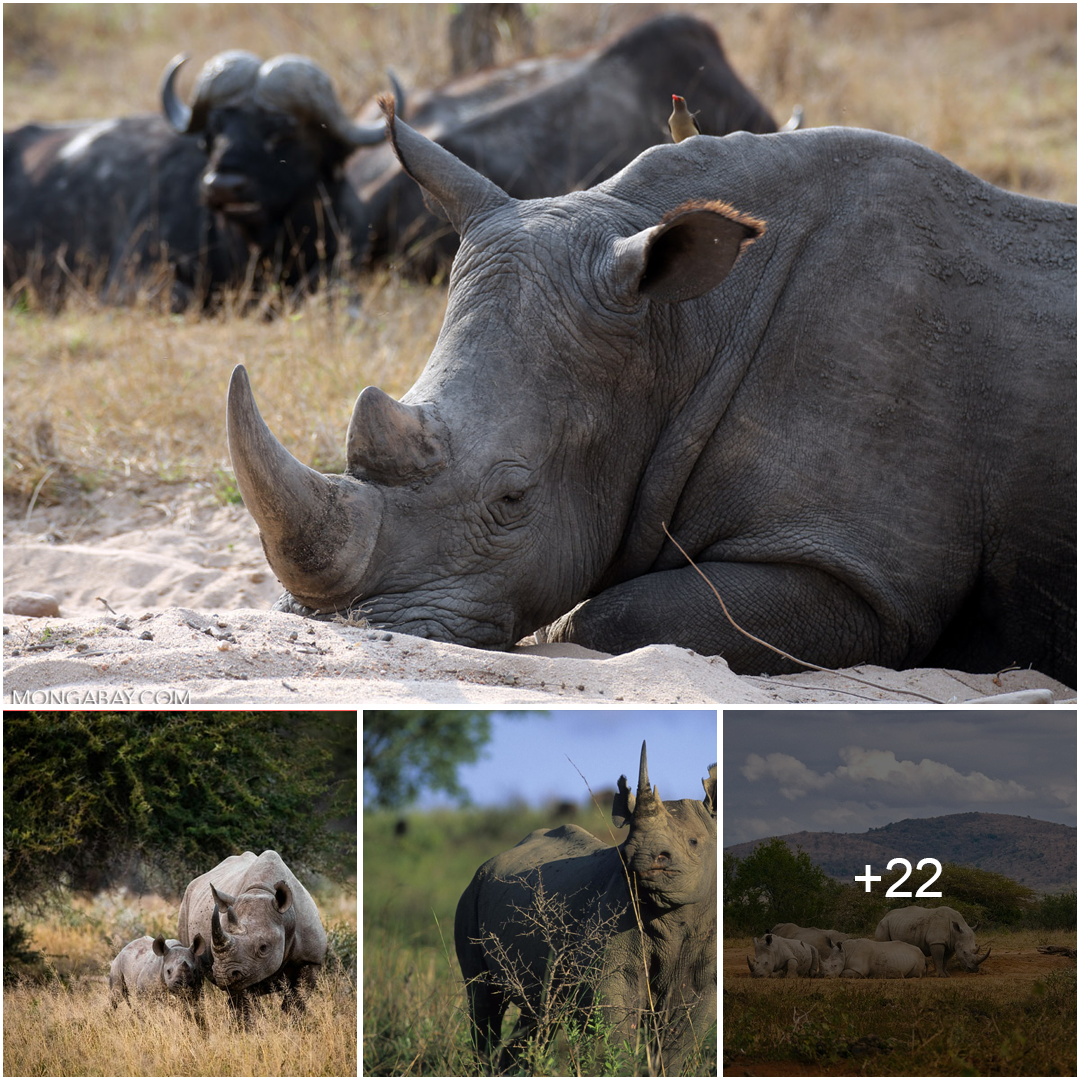
- New research finds climate change threatens black and white African rhinos by making their current habitats hotter, drier and less hospitable.
- Rhinos, unable to sweat, rely on shade, water and food sources that are becoming scarcer due to rising temperatures and arid landscapes.
- The study reveals that hotter periods will also likely force rhinos into areas with more humans, raising the risk of conflicts and compounding threats like poaching.
- Experts say strong global climate change mitigation efforts paired with on-the-ground adaptation tactics, such as shade-tree planting, corridor creation and misting stations, would give rhinos a fighting chance.
New research is ringing alarm bells about how climate change may impact one of Africa’s most iconic and vulnerable animals: the rhinoceros.
“Climate change has the potential of wiping out all of them in the blink of an eye,” says Hlelolwenkhosi Mamba, an Eswatini native and Fulbright scholar.
Mamba and Timothy Randhir, from the University of Massachusetts Amherst, spent two years obtaining climate modeling and rhino GPS coordinates in five national parks across Southern Africa to understand how two different climate change scenarios might impact the bulk of the world’s remaining black (Diceros bicornis) and white (Ceratotherium simum) rhinos, the two rhino species found in Africa.

Rhinos, unable to sweat through their super-thick skin, rely on nature for survival, requiring shade trees, mud pits and watering holes to regulate their body temperature. Climate change threatens these vital features, making them scarcer and altering rhino behaviors and population dynamics.
In a paper published in January, Mamba and Randhir write that hotter temperatures and increasingly water-starved landscapes will lead to the rhinos stress eating and spending more time escaping the heat, affecting their access to food, water and shade.
This will also likely send them into areas with more humans and conflict. On top of the ongoing risk of poaching, these climate change influences could drive rhinos to extinction in these parks by the end of the 21st century, the researchers warn.
“People think that rhinoceroses are very strong and robust and can handle it. But I think this study highlights their vulnerability and can hopefully bring more visibility to the climate change question,” Randhir says.
The findings are alarming, and the research duo say they hope this information will give humans the tools to help rhinos adapt to a rapidly warming world.
“I love rhinos. They are my favorite and I wish I had the resources to protect them from all that’s threatening them,” Mamba says. “If nothing is done to reduce our emissions, then their extinction due to climate change is imminent.”
Methods for a megafauna
Randhir and Mamba compiled location data on black and white rhinos to identify each species’ habitat preferences. Then they analyzed two emissions scenarios published by the U.N.’s Intergovernmental Panel on Climate Change (IPCC) — business-as-usual and high — for each of the five Southern African parks: Kruger in South Africa, Etosha in Namibia, Hwange in Zimbabwe, Tsavo West in Kenya, and Hlane Royal in Eswatini. From this, they were able to project temperature and precipitation changes and their impacts on rhino habitat suitability by 2050 and 2085.
The more moderate, business-as-usual scenario, known as RCP4.5, predicts average warming across the five parks of 2.2° Celsius (4° Fahrenheit) by 2055 from the pre-industrial baseline, and 2.5°C (4.5°F) by 2085.
The high-emissions scenario, RCP8.5, forecasts a 2.8°C (5°F) rise by 2055 and 4.6°C (8.3°F) by 2085.

In both scenarios, rhino habitats will become hotter and drier, except for Tsavo West National Park, which will see increased rainfall under the high-emissions scenario.
Habitats in Etosha National Park and Hlane Royal National Park could become entirely inhospitable for rhinos by 2085 under either scenario, with a real likelihood of extinction. As a conservationist and Eswatini resident, Mamba said, this is something the world needs to know now.
Not all black and white
For thousands of years, both black and white rhinos have held cultural importance for farming and hunter-gatherer communities throughout sub-Saharan African nations. In the Huns Mountains of southern Namibia, rock art paintings of rhinos date back 30,000 years. To the Shona peoples of Zimbabwe, Mozambique and South Africa, the black rhino or chipembere is known as “the dancer” for its supposed fashion of charging and stamping out campfires.
The Tswana, of Botswana and South Africa, believed that Mohoohoo, the white rhino, emerged from the same cave as their own original ancestor, and hold the animal in high regard. And to the San peoples across Southern African, both species are associated with rainmaking rituals, each bringing a type of rain appropriate to their temperament: — the more docile white rhino brings a soft rain, and the feistier black rhino commands thunderstorms.
That a rain-summoning pachyderm, incapable of sweating and dependent on watering holes and shade for cooling, is now threatened by drought and intolerable heat seems both ironic and unfair.
Randhir, an interdisciplinary academic at heart who grew up in India, a country with its own rhinos, said rhino conservation is complicated even at the best of times.
“Climate scenarios are having direct and indirect impacts,” he said, adding that it impacts rhinos’ “physiology, survival, the community structure, but also food access, habitat access, and safe places where they can survive without human conflicts.”
With drastic or even moderate reductions in global greenhouse gas emissions, Randhir said he hopes the 2.2°C warming by 2055 will be the worst-case scenario for rhinos — and people. But he added that adaptation strategies must be in place.

“We always have impacts coming from the cryosphere [polar regions and ice caps] like a polar bear losing their ice. But we never talk about climate impacts on dry environments, especially on rhinos and elephants who are so tied to water,” he said. “We were focusing on how parks can adapt and manage.”
Ensuring black and white rhinos have access to food, water, shade and habitat in places safe from human conflict is what Randhir and Mamba say they hope decision-makers, parks managers and conservation organizations will make happen.
They recommend installing misting stations and wallowing pits during peak temperature periods, planting more shade trees, and creating corridors between parks and patches of landscapes. Randhir said he believes rhinos might have a fighting chance if we can pair strong global climate change mitigation efforts with rhino-specific adaptation tactics on the ground.
“If we change our perspective in terms of creating landscapes which are much more resilient by adding corridors and core areas, reducing periphery boundaries where there is human conflict, understanding the regional migration issues between countries, and at a global scale agree on the mitigation of climate impacts, I think we have a hope,” he said.
A call to horns
For the last several decades, African rhino conservationists have primarily been concerned with poaching, a severe and ongoing threat. But climate change impacts on rhinos have been top of mind for at least one organization.
“Removing critters [creates] a disrupted ecosystem and impacts the carbon cycle,” says lifelong conservationist and International Rhino Foundation (IRF) executive director, Nina Fascione. “And rhinos have the double hit of poaching and the pretty grim scenario about rising temperatures and increased drought. It’s discouraging, and it causes some heart palpitations.”
Fascione and the IRF work in rhino range countries all over the world, including Zimbabwe and South Africa, where they support community-led initiatives by sharing stories, tactics and techniques on rhino protection, monitoring and research, as well as taking care of orphaned rhinos and helping fund habitat assessments to increase rhino ranges.

Although poaching is the primary concern for the IRF, any long-term threat to their survival is also a concern. And Fascione said she’s glad someone is drawing attention to a global problem that is both inflicted by and on rhinos and humanity.
“If we don’t know the challenges, we can’t address the challenges,” she said. “We just have to be very deliberate and thoughtful about protecting the spaces that rhinos need, protecting them from poaching, and getting a grip on climate change.”
To get there, Fascione said, conservation organizations, park managers and governments must pursue genuine partnerships that are led by local communities to protect habitats. These must include both climate change adaptation and mitigation strategies.
While she expressed fear, she also spoke of hope.
“Rhinos are incredible as the ecological agents that they are, and they’re just flipping cool and adorable,” Fascione said. “I’m madly in love with them and I really feel an obligation to try to protect what my generation inherited for the next generation, for my daughter and maybe someday a grandkid or two. I think we can do it.”


